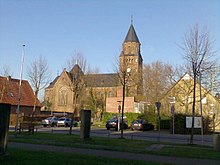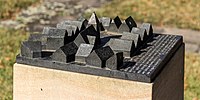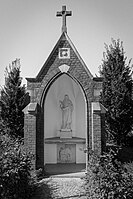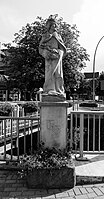Hiddingsel
|
Hiddingsel
City of Dülmen
|
|
|---|---|
| Coordinates: 51 ° 50 ′ 9 ″ N , 7 ° 24 ′ 9 ″ E | |
| Height : | 56 m above sea level NN |
| Area : | 6.76 km² |
| Residents : | 1752 (March 1, 2019) |
| Population density : | 259 inhabitants / km² |
| Incorporation : | 1st July 1969 |
| Incorporated into: | Hiddingsel |
| Postal code : | 48249 |
| Area code : | 02590 |
Hiddingsel is a village in the western Münsterland and district of the city of Dülmen in the Coesfeld district ( North Rhine-Westphalia ).
history
First mention and development
The name Hiddingsel was first mentioned in 1032 as a large yard, as a Schulzenhof . There are two versions of the origin of the name: One of them comes from the Anglo-Saxon male name "Hiddo". According to a second version, the syllable "Hid" is derived from the proper name "Hildi". The ending on "sel" indicates hall / barn / seat / settlement. At that time there were various main courtyards with associated sub-courtyards . One of these main courtyards was the Hiddingsel courtyard . The Hiddo farm was located on the western side of the village of Hiddingsel. A castle with a wide protective wall still stood here until 1893 . A moat ran around the castle . A depression still indicates it. The depression and the old flood of the Kleuterbach was bridged by a 12 m long Schemm ( Stegbrücke , Low German Schemm , High German Brett überm Bache ). In 1905, the Schemms were broken off and the Hiddingsel-Rödder road prepared for it.
The Hiddingsel farm was owned by the cathedral chapter of Münster . The cathedral chapter had a small chapel built on the grounds of this courtyard, which subsequently gave rise to the village. After 1240 Hiddingsel became a parish .
The Hiddingsel farm was gradually dismembered in the 13th century and left to the residents who settled there. As a replacement, on August 18, 1331, the Münster canon Burkhardt bought the feudal estate located in the Rödder peasantry and adjacent to Hiddingsel , "in order to still be able to exercise the rights of the lordship over the subordinates of the village."
At the beginning of the 16th century the parish lost its independence and became a rectorate . Only in 1861 a separate parish was set up again. The first pastor was the then rector Hoffschläger.
In 1803 the church property in Hiddingsel fell victim to secularization and so came to the Prussian Crown . In 1837 the Prussian government ceded the estate to the Duke of Croÿ .
Disasters in the history of the village
The church village of Hiddingsel may have had around 30 to 40 houses in the 15th and 16th centuries. During this time it was not spared from strokes of fate such as fire, plague , war and floods. In 115 years it was completely destroyed by fire four times, namely in 1587 - during the Spanish-Dutch War (1568-1609) the village was set on fire by "the Flemish" as well as the Dutch -, 1606, 1639 and 1702. For the fire of July 31, 1606, the following incident is transmitted: “This time the reason for the fire was not a military conflict, but a marital dispute. Johann Stobert's wife did not want to tolerate her alcoholic husband in her bed because she believed that he had drunk too much money in the tavern. There was a solid crash that culminated in the man - driven from his bedroom - sitting down with a burning candle in the hen house and falling asleep there. The candle set fire to his own house and, as a result, the whole village. ”On December 8, 1703, a hurricane-like storm destroyed the newly built houses and the church tower.
Around 250 people fell victim to the plague of 1636. According to an old legend, only three women who hid under a small bridge to protect themselves against the disease were said to have been spared the devastating disease. The bridge is still called “Frauenschemm” from this incident. A remnant of this time is the annual plague procession of the Catholic parish of St. Georg zu Hiddingsel.
In the years 1875, 1881, 1890, 1932, 1945 and 1963 the Kleuterbach flooded the whole village and the surrounding area. Hiddingsel was completely cut off from the outside world. The new flood saved the village from a flood disaster in 1981.
A total of 119 Hiddingseler lost their lives in the First and Second World Wars .
Incorporation - local government reform
Hiddingsel was incorporated into Buldern on July 1, 1969 . As part of a further regional reform that came into force on January 1, 1975, Hiddingsel became a district of the city of Dülmen .
politics
stand-in
Hiddingsel is represented in the city of Dülmen by the mayor as a link and contact person for the citizens. Wishes, suggestions and complaints can be taken up and passed on to the mayor , city council or a committee. Representative tasks can also be assigned.
Coat of arms
Since 1940 Hiddingsel has had its own coat of arms. Blazon : "In silver (white) a slanting five-pointed black tournament collar, above and below each a slanting red sword." The tournament collar was taken from the coat of arms of the gentlemen "von Tuchdorp". This is an old knight family. “Bruno von Tuchthorpe” calls himself “Pastor of Hiddingsel” in 1330 because he was obliged to maintain the pastor's office. The possession of the "von Tuchdorp" was acquired in 1331 by the Hiddo farm. The swords in the coat of arms indicate an old court, today called "Dingelke". The symbols shown in the coat of arms are closely related to the community.
Culture and sights
music
- The Kulturforum Hiddingsel, together with a local piano house, conducts a piano and chamber concert series that takes place regularly and is well-known in professional circles.
Buildings
- The Romanesque Catholic parish church of St. George , which was solemnly consecrated on August 21, 1911 . The "new" church was built on the "Bonenkamp", according to tradition an old cult site of the indigenous people from Hiddingsel.
- The chapel, known locally as "Düpmann's Chapel", is at the end of the village in the direction of Lüdinghausen .
- Schulze-Emptings mouse barn: This field barn stands entirely on stone feet in pyramid shape and protruding collar. It is therefore difficult for rodents to overcome this barrier and attack the grain harvest. In addition, this design offers protection against rising soil moisture. Typical of this design is the wooden stud frame - the so-called half-timbered structure. However, the barn door arranged in the middle is atypical. Usually the barn door is repeated on the opposite side so that the barn could be driven through with a team of horses - a cart. The barn passage is often offset to one side. On the one, wider side, the grain shells were deposited in summer for harvest. In the autumn or winter months, the threshing machine was then placed in the barn passage. The grain sheaves were fed in from one, wider side, the threshed grain filled into jute sacks and deposited on the narrower side of the barn. Incidentally, the barn is often assigned to Hiddingsel, but it belongs to the Rödder peasantry ( Dülmen parish ).
- Schulze-Waltering watermill
- Crucifixion group in the St. Georg Hiddingsel cemetery. The deceased priests of the Catholic parish of St. Georg zu Hiddingsel are noted on the base of the crucifixion group.
- Hiddingsel
education
In Hiddingsel there is the St. Georg Kindergarten and the St. Georg Municipal Catholic Primary School as well as the St. Georg Catholic Public Library .
leisure
- The Dortmund-Ems Canal with its disused branch offers a variety of leisure activities. Used for swimming and fishing in summer, it is popular with ice skaters and ice divers in winter.
- Hiddingsel is connected to several cycle paths. In addition to regional bike tours, the Dortmund-Ems Canal Route and the 100 Castles Route also pass Hiddingsel.
- The place has with the sports club SV Vorwärts Hiddingsel 1929 e. V. , the general shooting club e. V. 1695 with its own youth department, the singing association Sängerlust 1894 and other associations through a common, village-like club landscape. Village life is also by the Kolpingfamilie Hiddingsel Saint George, rural youth KLJB and the church dominated St. George.
Personalities
- J. Monika Walther , writer, lives in Hiddingsel. The tende publishing house, which she ran together with A. V. Uhlending, was also based here.
- Rolf Bauerdick , freelance journalist and writer, lived in Hiddingsel. In 2009 Rolf Bauerdick published his novel “How the Madonna came to the moon”, in which he tells of the life of the Roma in Romania in the last century. The novel is fiction, but it is based on many personal experiences.
- Erich Lütkenhaus , artist, holder of the Federal Cross of Merit, born in Hiddingsel in 1924.
literature
- Erik Potthoff, Dietmar Rabich: Dülmen - yesterday and today . Laumann-Verlag, Dülmen 2013, ISBN 978-3-89960-397-2 , Hiddingsel, p. 200-207 .
Web links
- Hiddingsel website
- Kulturforum-hiddingsel.de
- Hiddingsel in the Westphalia Culture Atlas
Individual evidence
- ↑ Website of the city of Dülmen, Dülmen in figures, population statistics (PDF; 13 kB), March 2019.
- ^ District of Dülmen
- ↑ Ravensberger Dictionary Low German High German ( Memento of the original from March 30, 2015 in the Internet Archive ) Info: The archive link was inserted automatically and has not yet been checked. Please check the original and archive link according to the instructions and then remove this notice.
- ↑ Martin Bünermann: The communities of the first reorganization program in North Rhine-Westphalia . Deutscher Gemeindeverlag, Cologne 1970, p. 96 .
- ^ Federal Statistical Office (ed.): Historical municipality directory for the Federal Republic of Germany. Name, border and key number changes in municipalities, counties and administrative districts from May 27, 1970 to December 31, 1982 . W. Kohlhammer, Stuttgart / Mainz 1983, ISBN 3-17-003263-1 , p. 313 .
- ↑ Heidrun Holtmann Piano Concerto , October 8, 2011
- ^ Like a magician and his assistant Dülmener Zeitung, February 17, 2013
- ↑ Philipp Bohnen - Berlin Philharmonic as a guest Gottschling event archive, March 25, 2014
- ↑ http://www.100schloesserroute.de/
- ↑ Sports club
- ↑ Rifle Club
- ↑ Kolping family
- ^ Parish of St. Georg















